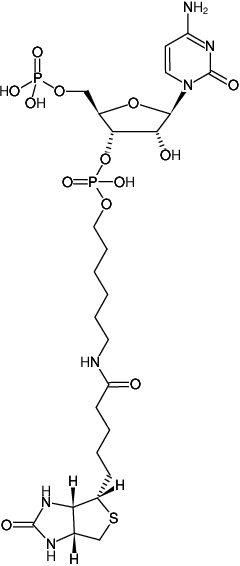No login/account required.
Your Basket/Online Quote
Items: 0 (0,00 €)
» Search & Order
» Sign in / Register
Your Basket/Online Quote
Items: 0 (0,00 €)
» Search & Order
» Sign in / Register
Cytidine-5'-phosphate-3'-(6-aminohexyl)phosphate, labeled with Biotin, Triethylammonium salt
| Cat. No. | Amount | Price (EUR) | Buy / Note |
|---|---|---|---|
| NU-1706-BIO | 20 μl (1 mM) | 162,60 | Add to Basket/Quote Add to Notepad |

For general laboratory use.
Shipping: shipped on gel packs
Storage Conditions: store at -20 °C
Short term exposure (up to 1 week cumulative) to ambient temperature possible.
Shelf Life: 12 months after date of delivery
Molecular Formula: C25H42N6O13P2S1 (free acid)
Molecular Weight: 728.65 g/mol (free acid)
Exact Mass: 728.20 g/mol (free acid)
Purity: ≥ 95 % (HPLC)
Form: solution in 10 mM Tris-HCl
Color: colorless to slightly yellow
Concentration: 1.0 mM - 1.1 mM
pH: 7.5 ±0.5
Spectroscopic Properties: λmax 271 nm, ε 8.9 L mmol-1 cm-1 (Tris-HCl pH 7.5)
Applications:
Incorporation into RNA/miRNA by
Description:
pCp-Biotin is recommended for 3'-End Labeling of RNA/miRNA with T4 RNA Ligase that conjugates a single Biotin molecule to the 3'-OH group of the RNA/miRNA template. The resulting Biotin-labeled RNA/miRNA probes are ideally suited for hybridization experiments such as microarray-based expression profiling or electro mobility shift assays (EMSA). Detection of the Biotin moiety can be performed using streptavidin conjugated with horseradish peroxidase (HRP), alkaline phosphatase (AP) or a fluorescent dye. Alternatively, Biotin-labeled RNA/miRNA probes can also be purified with Streptavidin-conjugated agarose/magnetic beads.
Related products:
BIOZ Product Citations:
Selected References:
Kashida et al. (2018) Nanoparticle-based local translation reveals mRNA as translation-coupled scaffold with anchoring function. doi:10.1101/483727.
Booy et al. (2016) RNA Helicase Associated with AU-rich Element (RHAU/DHX36) Interacts with the 3′-Tail of the Long Non-coding RNA BC200 (BCYRN1). J. Biol. Chem. 291 (10):5355.